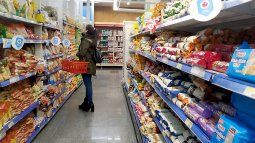The rains are still scarce in production areas. Lower international prices. Harvest progresses slowly. Soybeans are already imported. Paraná, with more flow, altered by union conflicts.
… that, while President Alberto Fernández negotiates with his Brazilian counterpart, Inácio Lula da Silva, today already one of the largest food producers in the world and that, instead of buying from Argentina (which will not even be able to supply the demand for wheat from the neighboring country), will provide it with soybeans to partially mitigate the high idle capacity this year, when a final harvest is expected in the country that may even drop below 23 million tons, while the main member of Mercosur, exceeded (with a record) 154 million, local producers are still “waiting for rain”. Rainfall, as this newspaper has already announced, should be around 150-180 mm, before the end of the month, in order to meet the apparent planting expectation of 6.5 million hectares of wheat, a crop that inaugurates the annual agricultural calendar. From there, surely the surface will go downhill. But along with the weather, also the security of supply of key inputs, is another unknown for production. “With yuan, fertilizers appear,” acknowledged a commercial source, tacitly alluding to the restrictions on access to dollars for imports from other origins. Meanwhile, the international market maintains a relative weakening. “In the US, corn and soybean sowing progress is coming at a faster pace, and good weather is expected for the coming weeks. This causes drops in prices for being one of the main producers and exporters. Added to this is the lower demand for this country due to competition for the entry of merchandise from Brazil that is finishing its harvest (…), and improves its competitiveness against the US,” says AZGroup analyst Catalina Ferrari, to explain the relative weakness also in the local market.
The content you want to access is exclusive to subscribers.
… that, while the effects of the dry season are beginning to be “felt” via the drop in collection and income from exports, the April Agroindustrial Monitor reports that soybean milling is the lowest in 18 years, at about 27 million tons, with a drop of 30% compared to last year. In addition, there was a sharp slowdown in sales by producers who, during March and April, barely offered around 2 million t, vs. 7 and 6 million sales, respectively, in 2022 and 2021. For several analysts, this responds, in part, to the advance sales of Soybean Plans I and II, but also the sharp drop in production of this last cycle, and the economic and exchange uncertainty now support the traditional caution of producers, to get rid of their holdings. On the contrary, the Monitor points out, the crushing of sunflower (the one with the best performance in this last cycle) increased sharply, which went from 224,000 to 443,000 t, with a growth of + 98%. Another product that also sold well (and took advantage of the agricultural dollar) is barley, although it may not be able to repeat that behavior in the current 23/24 season.


… that, while the differences around avian flu continue, which determined that CEPA, which brings together the main poultry companies, issued a press release in which it stated, regarding vaccination against the disease, that “for the moment , none of the vaccines that are in development showed successful results in their application”, although they recognize some improvement in mortality levels (decrease), but require permanent reassessment. They also emphasize that “no exporting country uses vaccination (USA, Brazil, Chile, European Union, etc.), and they disagree with the concept that” we are facing decisive hours. They believe, better, in deepening the care, defining the methodologies, and assigning a fund to the Ministry of Agriculture to compensate the producers for the slaughtered birds, an issue that recently generated a strong controversy that has not yet been fully clarified. In favor of poultry activity, simultaneously, the Poultry Meat Research Center published a very composed recipe book for the best use of chicken meat that, today in the country, equals that of beef, thus becoming a of the main alternatives in the animal protein market. In this regard, the specialist Luis Bameule also spoke when he stressed that “in the 1960s Argentina was the leading producer and exporter of beef”, for the businessman (the loss of that place) “constitutes self-inflicted damage”.
Source: Ambito




